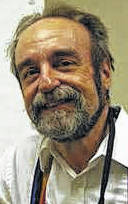
We continue our discussion of Galileo Galilei and his tempestuous relationship with the Roman Catholic Church.
Galileo championed the Copernican model — that the sun is at the center of the cosmos and that Earth and the other planets orbit the sun.
The church supported the Ptolemaic model. Ptolemy’s system involved a complex system of orbits within orbits called epicycles that allowed the Earth to stay at the center of things.
Using one of the first astronomical telescopes, which he designed and built himself, Galileo made several startling discoveries that he believed contradicted the Ptolemaic model.
His publication of those findings in his book “The Starry Messenger” in 1611 stirred up a controversy that resulted in a Vatican meeting with Cardinal Bellarmine in 1616. Bellarmine banned the book and ordered Galileo to cease public support for Copernicus.
And there things stood for seven years, long, long years for Galileo, who felt — justifiably — that he was sitting on world-altering observations.
Pope Paul V died in 1621. His successor, Gregory XV, passed in 1623.
The next pope was Galileo’s old friend Cardinal Barberini, who took the papal name Urban VIII. Galileo rushed to Rome to see if he could get his old buddy to rescind the 1616 Vatican prohibitions.
Urban balked at lifting the prohibitions, but he did provide moral support to Galileo. At least that’s the way Galileo told it.
He thus rushed home and began to write his great defense of the Copernican model, “Dialogo Dei Due Massimi Sistemi,” “Dialogue Concerning the Two Chief World Systems.”
Galileo structured the work as a debate between three friends. The dominant character is Salviati, a quick-witted defender of Copernicanism. He is pitted against Simplicio, the rather dim-witted proponent of the Ptolemaic model.
Salviati, the “wise one,” is a stand-in for Galileo. Simplicio, the ”simpleton,” represents the church’s position generally but with one disastrous argument.
Simplicio argues that God is omnipotent and thus could organize the cosmos in any way he wants to. We cannot deduce the true nature of the universe from scientific observation because God can make the cosmos look different than its actual form.
Unfortunately for Galileo, that argument was a favorite of Pope Urban. The pope, Galileo’s now former friend, took the association of his favorite argument and the dim-witted Simplicio as a grave insult.
The publication of the book in February 1632 caused an uproar.
Strangely, the work had been approved by the censors in both Florence, where Galileo resided, and the Vatican, which seemed to imply that the work had the imprimatur of the church.
It didn’t. The Inquisition banned the book in August 1632. Galileo’s enemies in the Vatican showed the work to Urban, who saw the character of Simplicio as a stand-in for the Pope. It thus demonstrated Galileo’s disrespect for his former friend and the papal institution in general.
Thus, Urban ordered Galileo to appear before the Inquisition. He was interrogated four times and threatened with torture. Just 32 years before, in 1600, Giordano Bruno had been burned at the stake for expressing similar astronomical opinions. The Inquisition meant business.
Significantly, the trial did not center on Galileo’s support of the Copernican model or the insult to the pope. Instead, they emphasized his meeting with Cardinal Barberini in 1616.
His accusers found a record of the meeting in Galileo’s Vatican file. According to the document, Galileo had been ordered “not to hold, teach, or defend in any way” Copernicus’s views.
Neither Galileo, nor Cardinal Bellarmine, nor any other church official had signed it. Some historians believe the document was a forgery cooked up by Galileo’s many enemies to ensure his condemnation.
To this day, no one is particularly certain what the cleric and the scientist said to each other during that fateful meeting.
In any case, the verdict was a foregone conclusion. Significantly, the church did not convict Galileo for the heresy of Copernicanism. Instead, they condemned him for his failure to follow the orders given to him in 1616.
And thus it was that on June 22, 1633, Galileo, aged 70, abased himself before the Holy Inquisition by abjectly kneeling on the cold stone floor and compliantly recanting his “errors.”
We’ll leave him there until next week.
Tom Burns is the former director of the Perkins Observatory in Delaware.

